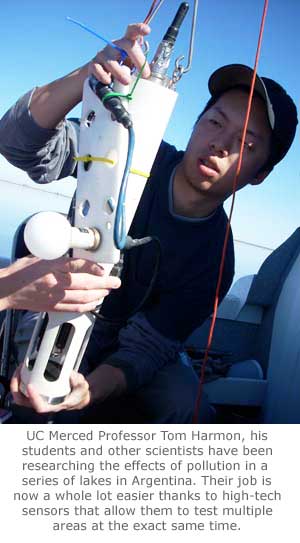

Imagine how our approach to a large-scale environmental problem like global climate change might be different today if a
network of sensorshad been in place for the last 50 years, providing coordinating data sets that clearly showed what was happening to the climate as we went along.
That’s the kind of solution now being explored for water quality and water ecosystems by an international team of
researchersled by UC Merced’s Professor
Tom Harmon.
A unique chain of saltwater lakes in Argentina, the Encadenadas del Oeste, are threatened by increasing pollution from agriculture and cities, and scientists in Argentina don’t have the resources to monitor them using traditional field-sampling techniques. But Harmon is working with colleagues in Argentina and the United States - as well as several UC Merced students - to make sure the lakes are under the watchful eye of science using efficient new sensing technologies.
Harmon coordinated a trip to the lakes earlier this year for an intensive four-day period of data gathering using environmental sensors. His team documented the health of algae, phytoplankton and bacteria in the lakes as well as environmental factors that influence them like air, soil, water, wind and weather. Their innovative approach allowed them to assemble more information in their very brief visit than they could have done in years using old-style sampling methods - what Harmon describes as put on your hip waders and grab your clipboard.
Sometimes, large-scale environmental problems are difficult to document or understand because things change so fast in so many places that it’s nearly impossible for scientists to observe them thoroughly enough, Harmon said. Carefully planned networks of embedded sensors can solve that problem.
That planning requires true collaboration among environmental engineers and computer or electrical engineers. To that end, Harmon participates with dozens of faculty members from UC campuses and other California universities in the Center for Embedded Networked Sensing, or CENS, organized to solve environmental engineering problems using advanced technology.
In the Encadenadas del Oeste, Harmon and his students and colleagues deployed 14 different kinds of sensors in each lake to gain a rich set of real-time data that they then could use to compare how all the lakes were doing at the same time - rather than weeks or months apart. That’s important because of seasonal variations.
Even better, the physical data could be analyzed on the spot. The team documented large increases in salinity in the lakes moving from higher to lower elevations along the lake chain. The biological data they gathered is now being analyzed.
Argentinean researchers now have plans to continue using sensors to monitor and model lakes, lagoons, wetlands, estuaries, dams and reservoirs throughout their country. Harmon envisions a global network of similar sensors providing coordinated data that could warn us of future crises in water quality, helping manage fisheries and agriculture more effectively or even reducing the incidence of water-borne diseases. Researchers in the United States are working to do their part to build such a network through the WATERS Network initiative, on which Harmon is a senior investigator along with two other UC Merced professors,
Roger Balesand
Martha Conklin.






